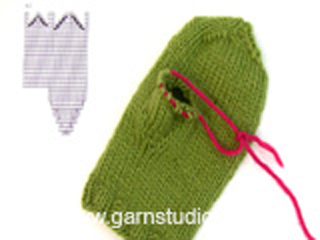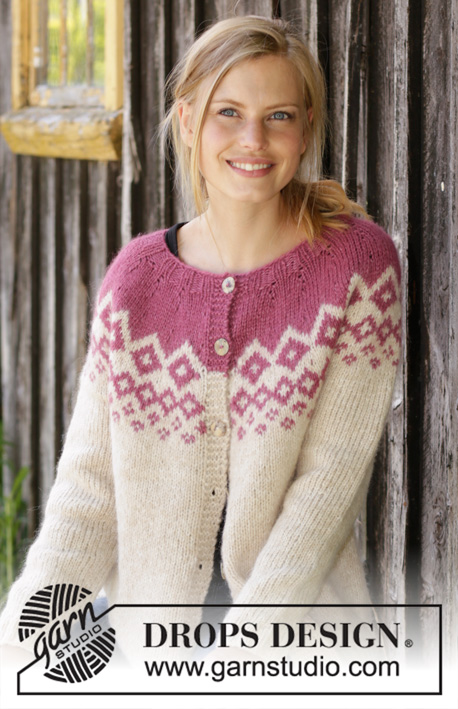Diamond Delight Accessories |
|||||||
|
|
|||||||
Knitted hat and mittens in DROPS Air with Nordic pattern.
DROPS 196-14 |
|||||||
|
---------------------------------------------------------- EXPLANATION FOR THE PATTERN: ---------------------------------------------------------- DECREASE TIP-1 (evenly): To calculate how to decrease evenly, use the total number of stitches on row (e.g. 96 stitches) and divide stitches by number of decreases to be done (e.g. 12) = 8. In this example decrease by knitting every 7th and 8th stitch together. KNITTING TIP: To avoid the knitting gauge to tighten when working pattern, it is important not to tighten the strands on back side of piece. Use a larger needle size when working pattern if needed. PATTERN: Hat: See diagram A.1. Work the entire pattern in stockinette stitch. Mittens: See diagrams A.2 and A.3. Work the entire pattern in stockinette stitch. DECREASE TIP-2 (applies to hat): Decrease 1 stitch after every marker thread as follows: Slip 1 stitch knitwise, knit 1, pass slipped stitch over stitch worked (= 1 stitch decreased). INCREASE TIP (applies to thumb gusset on mitten): Work the entire thumb gusset with wheat. Work until stitch with marker, make 1 yarn over, knit 1 (= stitch with marker), make 1 yarn over (= 2 stitches increased). On next round knit yarn overs twisted to avoid holes. On next increase work as follows: Work until 1 stitch remains before stitch with marker, make 1 yarn over, knit 3, make 1 yarn over (= 2 stitches increased). Continue increase like this every other round, i.e. always increase on the outside of the increased stitches. DECREASE TIP-3 (applies to top of mitten): Begin 3 stitches before marker and knit 2 together, knit 2 (marker is between these 2 stitches), slip 1 stitch knitwise, knit 1, pass slipped stitch over stitch worked (= 2 stitches decreased). ---------------------------------------------------------- START THE PIECE HERE: ---------------------------------------------------------- HAT - SHORT OVERVIEW OF THE PIECE: Worked in the round on circular needle, bottom up. Switch to double pointed needles when needed. HAT: Cast on 96-104-112 stitches on circular needle size 4 mm = US 6 with rose. Work rib in the round = knit 2/purl 2 for 4 cm = 1½". Switch to circular needle size 4.5 mm = US 7, knit 1 round while decreasing 12-14-16 stitches evenly - read DECREASE TIP-1 = 84-90-96 stitches. Read KNITTING TIP and work PATTERN - read explanation above, in the round according to A.1 (= 14-15-16 repetitions of 6 stitches). REMEMBER THE KNITTING GAUGE! When A.1 has been worked vertically, continue with rose and in stockinette stitch until finished measurements. When piece measures 19-20½-22 cm = 7½"-8⅛"-8¾", insert 6 markers in piece as follows: Insert first marker at the beginning of round, then insert the next 5 markers 14-15-16 stitches apart. On next round decrease 1 stitch after every marker - read DECREASE TIP-2 (= 6 stitches decreased). Decrease like this on every other round 3-4-4 times in total and then on every round 3-3-4 times in total = 48-48-48 stitches remain. Knit 2 rounds where all stitches are knitted together 2 by 2 on both rounds = 12-12-12 stitches remain. Cut the yarn and pull it through the remaining stitches, tighten together and fasten. Hat measures approx. 24-26-28 cm = 9½"-10¼"-11" in total from top and down. ---------------------------------------------------------- MITTENS - SHORT OVERVIEW OF THE PIECE: Worked in the round on double pointed needles. RIGHT MITTEN: Cast on 40-40-44 stitches on double pointed needles size 3.5 mm = US 4 with rose. Knit 1 round. Work rib in the round = knit 2/purl 2 for 4 cm = 1½". Switch to double pointed needles size 4 mm = US 6, knit 1 round while decreasing 4-4-2 stitches evenly - read DECREASE TIP-1 = 36-36-42 stitches. Read KNITTING TIP and work PATTERN - read explanation above, in the round according to A.2 (= 6-6-7 repetitions of 6 stitches). REMEMBER THE KNITTING GAUGE! When A.2 has been worked vertically, continue with wheat and in stockinette stitch. When piece measures 9 cm = 3½", insert 1 marker in first stitch on round. Now increase for thumb gusset by increasing 1 stitch on each side of stitch with marker - read INCREASE TIP (= 2 stitches increased). Continue increase for thumb gusset every other round 5-6-7 times in total = 46-48-56 stitches. Continue to work without increase until piece measures 14-15-16 cm = 5½"-6"-6¼". On next round slip the next 11-13-15 thumb gusset stitches on a stitch holder, continue in the round with wheat and at the same time cast on 1 new stitch on needle over stitches on stitch holder = 36-36-42 stitches. Then work A.3 in the round (= 6-6-7 repetitions of 6 stitches). When A.3 has been worked vertically, continue with wheat and in stockinette stitch until finished measurements. Work until mitten measures 22-23-24 cm = 8¾"-9"-9½" (approx. 4 cm = 1½" remain until finished measurements, try the mitten on and work to desired length). Insert 1 marker thread at beginning of round and 1 marker thread after 18-18-21 stitches. On next round decrease 1 stitch on both each side of both marker threads – read DECREASE TIP-3 (= 4 stitches decreased). Decrease like this on every other round 3-3-3 times in total and then on every round 2-2-2 times in total = 16-16-22 stitches remain. Knit 2 rounds where all stitches are knitted together 2 by 2 on both rounds = 4-4-6 stitches remain. Cut the yarn and pull it through the remaining stitches, tighten together and fasten. Mitten measures approx. 26-27-28 cm = 10¼"-10⅝"-11" from top and down. THUMB: Slip the 11-13-15 thumb gusset stitches from stitch holder back on double pointed needles size 4 mm = 6 and pick in addition up 4-4-4 stitches behind thumb with wheat = 15-17-19 stitches. Work in stockinette stitch in the round until the thumb measures 5-5½-6 cm = 2"-2⅛"-2⅜" (approx. ½ cm = ⅛" remain until finished measurements, try the mitten on and work to desired length). Knit 2 rounds where all stitches are knitted together 2 by 2 on both rounds = 4-5-5 stitches remain. Cut the yarn and pull it through the remaining stitches, tighten together and fasten. LEFT MITTEN: Cast on and work the same way as right mitten but when increasing for thumb gusset insert marker in last stitch on round. Work the rest of the mitten the same way as right mitten. |
|||||||
Diagram explanations |
|||||||
|
|||||||

|
|||||||
|
Have you made this or any other of our designs? Tag your pictures in social media with #dropsdesign so we can see them! Do you need help with this pattern?You'll find tutorial videos, a Comments/Questions area and more by visiting the pattern on garnstudio.com. © 1982-2024 DROPS Design A/S. We reserve all rights. This document, including all its sub-sections, has copyrights. Read more about what you can do with our patterns at the bottom of each pattern on our site. |
|||||||






















































Comments / Questions (5)
Dobrý den, na jaké velikosti jehlic se plete zkušební vzorek? (konkrétně u této čepice i obecně - nikde to není napsané a tak pletu zkušební vzorky na těch hlavních jehlicích (ne velikost pro lemy) a jednou mi to vychází, že moc utahuji, podruhé, že pletu moc volně... Děkuji
28.01.2023 - 19:36DROPS Design answered:
Milá Johano, postupujete naprosto správně! Zkušební vzorek pleteme vždy na těch "hlavních" jehlicích (pokud není výslovně uvedeno jinak). To, že se hustota vašeho vzorku zcela neshoduje s tím v návodu, je zcela normální - každý plete jinak, i jednotliví návrháři, i vy. Proto je dobré vždy vzorek udělat a míry si srovnat. Mohl by se vám také hodit náš článek Jak změřit hustotu úpletu . Hodně zdaru! Hana
30.01.2023 - 06:36Hi , I would like to knit this set. Confused about how many balls of Drops Air to purchase. As stated: 100-100-100 g colour 14, heather 50-50-50 g colour 02, wheat Is that six balls of Heather and three balls of wheat? Thank you in advance for any help. Please take care.
05.07.2021 - 21:14DROPS Design answered:
Dear Lydia, the set (hat and mittens) is knitted from DROPS Air yarn that comes in 50 gramms ball, so you will need 100 gramms (2 balls) of the heather color, and 50 grams (1 ball) od the wheat color. Happy Knitting!
05.07.2021 - 21:46Hello! I am knitting this hat and after decreasing 16 stitches (XL size) it is very small for me. What can I do now to make a proper hat?
12.07.2020 - 13:02DROPS Design answered:
Dear Lera, did you check your tension? You should have 18 sts = 10 cm in width - read more about tension here. Happy knitting!
13.07.2020 - 09:08When I do the gusset increase I have one line up which is the stitch with the marker. It doesn’t look like your tutorial. I can’t interpret the instructions to come out the same as the tutorial because it seems to me that I’m doing exactly what it says. However it looks different. Do you have any clearer diagrams or photos of it. Totally confused!
30.03.2020 - 14:24DROPS Design answered:
Dear Mrs Stok, when working gousset for thumb you have to increase on each side of the stitch with the marker. This means there will be always more stitches between each increase, first time you will have: Inc 1, K1 (=marker), Inc 1. Then you will have: Inc 1, K3 (marker is in the middle st), Inc 1. Then: inc 1, K5 (marker is in the middle st), inc 1 and so on until you have increased all sts (5-6-7 sts on each side of the stitch with marker). Happy knitting!
30.03.2020 - 15:11Bonjour Merci pour vos merveilleux modèles et vos très belles laines. Je tricote le pull et le bonnet ci dessus en brushed alpaca silk et j observe je pense une erreur sur les 2 derniers rangs de la grille du bonnet A1. En effet si je respecte la grille , je termine avec la couleur opposée. Vous pouvez vérifier s il vous plaît ? Merci beaucoup.
22.11.2019 - 10:09DROPS Design answered:
Bonjour Patricia, je ne suis pas sûre de bien comprendre, à l'avant-dernier rang de A.1, vous tricotez: *2 m bruyère, 3 m blé, 1 m bruyère* et répétez de *-* (vous aurez ainsi 3 m bruyère, 3 m blé tout le tour. Puis, vous tricotez: *3 m bruyère, 1 m blé, 2 m bruyère*, vous aurez ainsi 5 m bruyère, 1 m blé tout le tour. Bon tricot!
22.11.2019 - 10:59